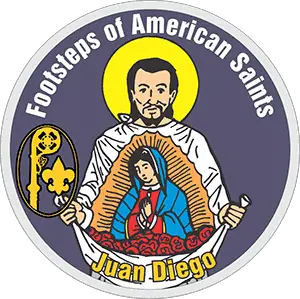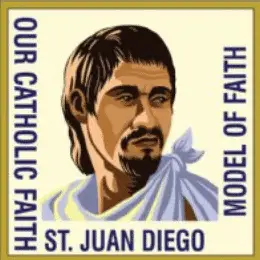Saint Juan Diego Cuauhtlatoatzin is an indigenous Mexican saint who holds a significant place in Catholic faith, particularly among Mexican and Hispanic communities. Canonized by Pope John Paul II, Juan Diego's vision of the Virgin Mary as Our Lady of Guadalupe has become an iconic symbol of faith and devotion.
Born around 1474 in Cuautitlán, near Mexico City, Juan Diego's early life was marked by his indigenous heritage and the rich cultural traditions of his people. However, it was his encounter with Spanish missionaries that would change the course of his life. Through their teachings, Juan Diego embraced Christianity and became a devout follower of the faith.
The Apparition of Our Lady of Guadalupe to Juan Diego is a pivotal event in his life and in the history of Catholicism in the Americas. In 1531, the Virgin Mary appeared to Juan Diego on the Hill of Tepeyac, delivering a message of love, compassion, and hope. She instructed him to build a church in her honor, and as a sign, she left her image imprinted on Juan Diego's cloak, known as the Tilma.
This miraculous image, which still exists today, has captivated believers and skeptics alike. Its preservation and unexplained qualities have inspired countless pilgrimages and conversions. The image serves as a powerful reminder of the enduring presence of Our Lady of Guadalupe and her message of unity and love.
The legacy of Saint Juan Diego extends beyond his own time. His story continues to inspire and teach important lessons about faith, humility, and the power of divine intervention. Today, his devotion remains strong, and his example serves as a beacon of hope for those seeking spiritual guidance and connection with the divine.
Early Life and Conversion
Juan Diego Cuauhtlatoatzin was born around 1474 near Mexico City, in the region of Cuautitlán. Growing up, he was deeply connected to his indigenous heritage and immersed in the rich cultural traditions of his people. However, his life took a significant turn when Spanish missionaries arrived in the area.
The arrival of the missionaries introduced Juan Diego to Christianity, and he was captivated by their teachings. He saw in the faith a path to spiritual fulfillment and a deeper understanding of the world around him. Inspired by their message of love and salvation, Juan Diego made the decision to convert to Christianity.
His conversion marked a profound shift in his life. Juan Diego embraced the teachings of the missionaries wholeheartedly and became a devout follower of the Christian faith. He sought to live out the principles of love, compassion, and humility in his daily life, striving to be a vessel of God's grace.
Juan Diego's early life and conversion serve as a testament to the transformative power of faith. His journey from his indigenous roots to embracing Christianity highlights the universal nature of spirituality and the capacity for individuals to find meaning and purpose in their own unique ways. Juan Diego's story is a reminder that faith can transcend cultural boundaries and unite people in a shared pursuit of truth and divine connection.
The Apparitions of Our Lady of Guadalupe
The Apparitions of Our Lady of Guadalupe to Juan Diego were a series of profound encounters that forever changed the course of history. In December 1531, the Virgin Mary appeared to Juan Diego, an indigenous man, on the Hill of Tepeyac near Mexico City. These apparitions were not only significant for Juan Diego personally but also held immense cultural and spiritual significance for the indigenous people of Mexico.
During the first apparition, the Virgin Mary spoke to Juan Diego in his native Nahuatl language, demonstrating her deep understanding and connection to the indigenous people. This act of speaking in the native language was a powerful affirmation of the worth and dignity of the indigenous culture and people. It showed that Mary's message of love and salvation was meant for all, regardless of their cultural background.
In subsequent apparitions, the Virgin Mary revealed her desire for a church to be built on the Hill of Tepeyac. She instructed Juan Diego to convey this message to the local bishop. However, the bishop was skeptical and requested a sign as proof of the authenticity of Juan Diego's claims. In response, the Virgin Mary instructed Juan Diego to gather roses from the barren hill, which he then presented to the bishop. As Juan Diego opened his cloak to reveal the roses, a miraculous image of the Virgin Mary appeared on the fabric, imprinted with the vibrant colors and features of the indigenous people.
The significance of Mary appearing with indigenous features cannot be overstated. It was a powerful affirmation of the indigenous people's worth and identity, and it served as a bridge between their indigenous heritage and their newfound Christian faith. This miraculous image, known as Our Lady of Guadalupe, became a symbol of hope, unity, and divine intervention for the indigenous people of Mexico.
The apparitions of Our Lady of Guadalupe to Juan Diego continue to inspire and resonate with people around the world. They remind us of the universal nature of Mary's love and her desire to reach out to all people, regardless of their cultural or linguistic background. The apparitions serve as a testament to the power of faith, the importance of cultural inclusivity, and the transformative impact of divine encounters.
The Miraculous Image
The story of the miraculous image of Our Lady of Guadalupe on Juan Diego's tilma (cloak) is a testament to the power of divine intervention and its profound impact on the lives of millions of people. After the Virgin Mary appeared to Juan Diego on the Hill of Tepeyac, she instructed him to gather roses from the barren hill and present them to the skeptical bishop as a sign. As Juan Diego opened his cloak to reveal the roses, a miraculous image of the Virgin Mary appeared on the fabric.
This image, known as Our Lady of Guadalupe, is a remarkable blend of indigenous and Christian symbolism. The vibrant colors and features of the image reflect the indigenous people of Mexico, serving as a powerful affirmation of their worth and identity. The image also incorporates Christian symbols, such as the rays of light surrounding the Virgin Mary, which represent her divine nature.
The miraculous image played a crucial role in the conversion of millions of indigenous people to Christianity. Prior to the apparitions, the indigenous people of Mexico had their own rich spiritual traditions and beliefs. The appearance of the Virgin Mary with indigenous features bridged the gap between their indigenous heritage and the Christian faith, making it more accessible and relatable to them.
The image became a powerful symbol of hope, unity, and divine intervention for the indigenous people. It provided them with a tangible representation of their faith and a source of comfort and inspiration. The image also served as a catalyst for the spread of Christianity among the indigenous population, as they saw in it a confirmation of the truth and power of the Christian message.
The impact of the miraculous image extended far beyond the indigenous population of Mexico. It captured the attention and devotion of people from all walks of life, transcending cultural and linguistic barriers. The image became a unifying force, bringing together people from different backgrounds and fostering a sense of shared faith and community.
Even today, the image of Our Lady of Guadalupe continues to inspire and resonate with people around the world. Pilgrims from all corners of the globe visit the Basilica of Our Lady of Guadalupe in Mexico City to pay homage to the miraculous image. The image serves as a reminder of the universal nature of Mary's love and her desire to reach out to all people, regardless of their cultural or linguistic background.
For more information about the significance of various parts of the image, see the article on Our Lady of Guadalupe.
Legacy and Lessons for Today
Juan Diego's legacy as a symbol of faith, humility, and obedience continues to inspire and resonate with Catholics today. His story serves as a powerful reminder of the transformative power of encountering the divine and the importance of responding with trust and obedience.
One of the key lessons we can learn from Juan Diego's life is the importance of faith in the face of adversity. Despite facing skepticism and doubt from the bishop, Juan Diego remained steadfast in his belief in the Virgin Mary's message. His unwavering faith serves as a model for us to trust in God's plan, even when it may seem difficult or uncertain.
Juan Diego's humility is another aspect of his legacy that we can draw inspiration from. Despite being chosen by the Virgin Mary for a special mission, he never sought recognition or glory for himself. Instead, he humbly carried out the tasks entrusted to him, always putting the needs of others before his own. This humility reminds us to approach our own faith journey with a humble and servant-hearted attitude, seeking to serve and love others as Christ did.
Lastly, Juan Diego's obedience to the Virgin Mary's instructions teaches us the importance of listening and responding to God's call in our lives. He did not question or doubt the message he received, but instead followed it faithfully. This obedience challenges us to examine our own lives and consider how we can better align our actions with God's will.
In today's fast-paced and often chaotic world, Juan Diego's legacy serves as a beacon of hope and inspiration. His story reminds us of the power of faith, humility, and obedience in our own lives. By embracing these qualities, we can deepen our relationship with God and become instruments of His love and mercy in the world.
Patron Saint of ...
He is the patron saint of the indigenous people of the Americas.
Mass Readings for the Optional Memorial of Saint Juan Diego Cuauhtlatoatzin
- First Reading – 1 Corinthians 1:26-31: God chose the foolish, weak, and lowly, overturning worldly standards, so none can boast except in the Lord, who is our wisdom, righteousness, and redemption.
- Responsorial Psalm – Psalm 131: Rejecting arrogance and pride, I seek not grand ambitions but remain calm and content like a child in its mother's embrace, placing my hope in the Lord.
- Gospel – Matthew 11:25: Jesus praised the Father for revealing divine truths to the humble and childlike, hidden from the wise and learned. He emphasized the exclusive mutual knowledge between Him and the Father, extending the opportunity for revelation to those He chooses. Inviting the weary and burdened, Jesus offered rest, urging them to embrace His gentle and humble teachings for soulful peace, with His yoke being easy and burden light.
Resources
Video
More Resources

St. Juan Diego Activity Patch
This patch encourages youth to learn about St. Juan Diego and to do activities related to him. Activities include making paper roses, drawing a picture, praying the rosary, and telling someone about Our Lady of Guadalupe. The patch is sponsored by the National Catholic Committee on Scouting, but can be earned by any youth, whether in Scouts or not.

Another Juan Diego Patch
This patch is sponsored by the National Catholic Committee for Girl Scouts and Camp Fire, but can also be earned by any youth. To earn the patch, youth walk to a weekday Mass and attend Mass in a different language than their own. They also learn about evangelization and about multicultural ministries.
Frequently Asked Questions
What date is the Feast of Saint Juan Diego?
It is observed annually on December 9.
The next date for the optional memorial is Tuesday December 9, 2025.
What are the Mass readings for the Optional Memorial of Saint Juan Diego Cuauhtlatoatzin?
First Reading – 1 Corinthians 1:26-31: Divine Choice of the Lowly
Responsorial Psalm – Psalm 131: Contentment in Humility
Gospel – Matthew 11:25: Revelation to the Humble
Who was St. Juan Diego Cuauhtlatoatzin?
St. Juan Diego Cuauhtlatoatzin was an indigenous Mexican peasant who is known for telling the world about Our Lady of Guadalupe. He was born in 1474 and lived in Cuautitlán, which is near Mexico City.
What is the significance of Saint Juan Diego?
Saint Juan Diego is significant because of his role in the apparitions of Our Lady of Guadalupe. His encounters with the Virgin Mary and the miraculous image that appeared on his cloak have had a profound impact on Catholic spirituality and devotion.
How many apparitions did Saint Juan Diego have?
He had a total of four apparitions of the Virgin Mary. The first occurred on December 9, 1531, and the last on December 12, 1531.
What did the Virgin Mary say to Saint Juan Diego during the apparitions?
During the apparitions, the Virgin Mary spoke to Saint Juan Diego in his native language of Nahuatl. She asked him to go to the bishop and request the construction of a church.
Did Saint Juan Diego face any challenges in delivering the message to the bishop?
Yes, the bishop was initially skeptical of Juan Diego's claims and requested a sign from the Virgin Mary to confirm her identity.
What was the sign that the Virgin Mary gave to Saint Juan Diego?
The Virgin Mary instructed Saint Juan Diego to gather roses from the top of Tepeyac Hill, even though it was winter. When Juan Diego presented the roses to the bishop, an image of the Virgin Mary miraculously appeared on his cloak.
What is the significance of the miraculous image of Our Lady of Guadalupe which appeared on Juan Diego's Tilma?
The image of Our Lady of Guadalupe had a profound impact on the indigenous people of Mexico. It served as a powerful symbol of unity and helped to bridge the gap between the indigenous culture and the Catholic faith brought by the Spanish conquistadors.
Who is St. Juan Diego the patron saint of?
He is the patron saint of the indigenous people of the Americas.
From his humble beginnings as an indigenous peasant to his pivotal role in the apparitions of Our Lady of Guadalupe, Saint Juan Diego continues to inspire and captivate believers around the world. His story serves as a testament to the power of faith, the importance of obedience, and the transformative nature of encountering the divine. Through his intercession, we are invited to deepen our own relationship with God and seek the virtues of humility, trust, and devotion that he exemplified.
Saint Juan Diego Cuauhtlatoatzin has left an indelible mark on Catholic spirituality and continues to be a source of inspiration for believers around the world. His story of faith, humility, and obedience serves as a powerful reminder of the transformative power of encountering the divine.
Throughout his life, Juan Diego demonstrated unwavering faith in the face of adversity. Despite facing skepticism and doubt, he remained steadfast in his belief in the message of the Virgin Mary. His example encourages us to trust in God's plan, even when it may seem difficult or uncertain.
Juan Diego's humility is another aspect of his legacy that resonates with believers. Despite being chosen for a special mission, he never sought recognition or glory for himself. Instead, he humbly carried out the tasks entrusted to him, always putting the needs of others before his own. This humility challenges us to approach our own faith journey with a humble and servant-hearted attitude.
As we reflect on Juan Diego's life, we are also reminded of the importance of obedience to God's call. He listened attentively to the Virgin Mary's instructions and followed them faithfully. This obedience prompts us to examine our own lives and consider how we can better align our actions with God's will.
In conclusion, Saint Juan Diego's impact on Catholic spirituality is profound. His enduring relevance lies in his unwavering faith, humility, and obedience. We are encouraged to seek his intercession and to emulate his virtues of humility and devotion. By doing so, we can deepen our relationship with God and become instruments of His love and mercy in the world.

Leave a Reply